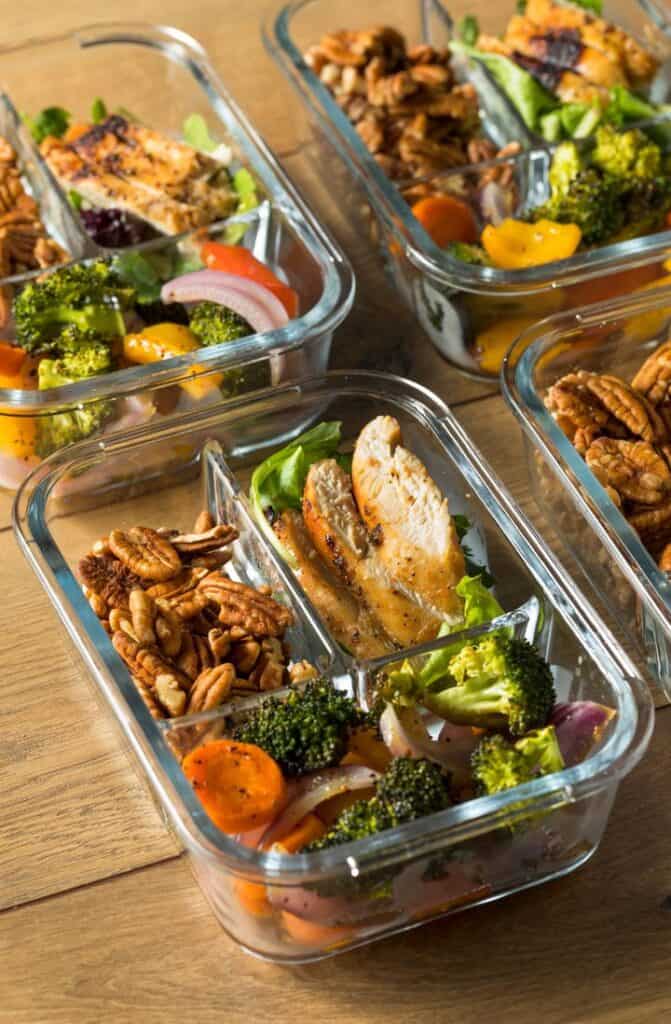Eating healthy is something a lot of people talk about, but honestly, what does it mean to eat healthy? For some people, eating healthy means vegan, for others, it means no longer eating out. It can even mean adding 3-5 servings of fruits and vegetables to your daily diet. Healthy looks different for everyone but ultimately, a healthy diet is a well-rounded diet loaded with an assortment of nutrients, protein, healthy fats, and enough carbs to support your activity level.
Importance of Eating Healthy
So what’s all the fuss about eating healthy anyways? Eating healthy looks so different from one person to the next that it may be challenging to decipher what a healthy diet looks like and decide which diet to follow.
At the end of the day, when you eat healthy, you eat a diet that supplies your body with all the vitamins and nutrients it needs to complete the daily functions you demand. You should also be eating enough food to fuel your body for the activities it does; eating enough is a huge part of eating healthy.
Eating healthy does not mean you must follow a specific diet by all the rules or cut out every sweet treat, carb-rich food, or fat-rich snack. It looks different for everyone, and there is no one size fits all approach. As you go through life, your body’s needs may change, and your diet could change due to that.
Listening to your body closely tells you exactly what you need, and the key is listening to the signs and signals your body gives. Factors like weight gain or rapid weight loss can absolutely contribute to your eating habits and should be monitored. You must change your diet to lose weight, sometimes eliminating or limiting certain foods, items or groups, but it is not always required.
That being said, any changes that you make to your diet should be changes that you can commit to long-term, otherwise, is it really healthy eating? Healthy eating is an approach that can be easily incorporated and stuck with for the long haul. This is why dramatic changes and over-the-top restrictions are not the best approach.

Setting Realistic Goals for Success
Setting realistic goals for yourself is one of the most important pieces to the success puzzle. If you set goals that will be extremely hard to reach or do not break the long-term goal into smaller pieces, then it may be challenging to see your success and stick with whatever changes you make.
If you aim to lose 100 pounds, it is wise to set smaller goals to help you reach the end goal. For example, set out to try to lose 5-10 pounds per month to start and reduce eating out to twice per month.
Setting smaller goals to get to your larger goal is a great way to stay motivated because your ability to achieve goals regularly increases, which acts like a reward and may help keep you excited about continuing your journey.
It is also okay to modify your goals. If one goal starts to seem impossible, then you can modify the goal to be something more achievable rather than giving up completely.
Every person’s experience with eating healthy is different, and what you may need to do to be successful is also different. The most important part is remaining consistent and motivated to make the changes and incorporating as many healthy foods as possible on a regular basis.

Understanding the Basics of Nutrition
Understanding the basics of nutrition helps you understand what your body needs and how to optimize your nutrition in a way that works well for you.
Macro and Micronutrients
Macronutrients, including carbohydrates, proteins, and fats, are essential nutrients that provide energy to the body. You have likely heard of the three macros and have some idea of what they do for your body.
- Carbohydrates are meant to provide the body with energy and can be found in grains, fruits, vegetables, and legumes.
- You need proteins to facilitate body tissue growth, repair, and maintenance. Proteins are found in lean meats, poultry, fish, sea food, dairy products, legumes, and plant-based sources.
- The other macronutrient is fat. Healthy fats are important for various functions and can be found in avocados, nuts, seeds, olive oil, and fatty fish.
Then we have micronutrients which include vitamins and minerals, which are required in smaller amounts but play crucial roles in bodily functions. Vitamins are organic compounds obtained from a balanced diet rich in fruits, vegetables, whole grains, and lean proteins.
Minerals like calcium, iron, zinc, potassium, and magnesium are inorganic substances necessary for proper bodily functions and can be found in foods like dairy products, leafy greens like spinach, peanut butter, and legumes.
Balancing Macronutrients
Each macronutrient plays a vital role in the body, and a balanced diet should include a combination of carbohydrates, proteins, and fats. The specific ratio of macronutrients varies depending on individual needs, activity levels, and health goals.
It is not as complicated to balance macros as you may think. Surprisingly enough, dishes like a salad, pizza, a sandwich, and even a burger can easily include a balance of all three macros. It is even possible to make a dessert that has all three!
You can consult with a healthcare professional or registered dietitian who can help determine the ideal balance for your body and activity level. Individual nutrient needs may vary based on factors like age, sex, activity level, and health conditions, so getting professional assistance is helpful.

Planning and Preparing Meals
Having a plan is one of the surefire ways to succeed in eating healthy. Healthy meals do not have to be complicated. Taking the time to plan snacks and meals and even prepare them ahead of time makes it easier to stay on track and maintain a healthy diet.
Creating a Balanced Meal Plan
Consider your dietary needs, level of physical activity, weight goals, and health concerns, and use this information to create a meal plan that helps you to eat the proper balance of macros and other vitamins and nutrients.
When you are doing your grocery planning and shopping, including a wide array of healthy lean proteins like fish, sirloin steak, extra lean ground beef, ground turkey breast, pork loin, and chicken breast.
You can create meals around these lean proteins by including carbohydrate sources like starchy vegetables, whole grains like brown rice, and healthy fats like olive oil, avocado, and nuts. From there, add some green leafy vegetables and other brightly colored produce like tomatoes and peppers.
Planning Snacks
When you plan your snacks, ensure they include a healthy balance of protein, carbs, and fats. Aim to prepare snacks that combine things like yogurt, berries, and granola with nuts. A snack like this hits all the main food groups, and the high protein content will help to keep you full, so you are less likely to head to the pantry for things like chips and candy.
Try your best to cut up fruits and vegetables so they are ready for snacking and have protein sources readily portioned out so you can grab them and go. Foods like cottage cheese, hard-boiled eggs, cheese, and great protein options can be paired with products like baby carrots, strawberries, and sugar snap peas.
Don’t forget to grab a pinch of nuts or nut butter for dipping to get your healthy fats into the mix.
Meal prepping
Cooking large amounts of food to portion out and have ready for the week is one way to successfully eat healthy. It may seem overwhelming initially, but cooking up a couple of lean protein options and having carbs like rice or potatoes ready to pair makes for easy mix-and-match meals.
You can easily spread asparagus, broccoli, and green beans on a baking sheet for roasting and then divide these vegetables' amounts of the protein and carbs you have already prepared. You need not complicate this by having proteins or vegetables cooked using different methods. Simply switch up the seasoning but keep the preparation methods the same.
You can also cook large portions of healthy pasta full of protein, veggies, and whole grains, divide it until containers are readily portioned for your next meal, or prepare healthy balanced casserole dishes for easy portioning. Things like soups are also great meal prep options.

Making Smart Food Choices
Making smart food choices is easier than it seems. Once you know what you are looking for or need to avoid, the process becomes smoother and like second nature.
Reading Food Labels
You can make healthier choices by taking a few extra moments to look at a food label. While you should not always fixate on calories, comparing two-label options and choosing the lesser-calorie similar options can add up over time and make a difference.
You can also look for ingredients you know your body does not react well to or are trying to avoid as part of your healthy eating plan.
Nutrition labels provide a lot of helpful information, and if you are trying to be calorie conscious, then paying some attention to labels can help you become more informed of nutrition density and calories in different food items, which can lead to better decisions that help you get closer to your goals.
Understanding Portion Sizes
Portion sizes refer to the amount of food we choose to eat at a given time. Paying attention to portion sizes is important as they directly impact our calorie intake and overall nutritional balance.
When you practice proper portion control, it helps prevent overeating and promotes a healthy weight. Portion sizes vary depending on the food and individual needs. It is beneficial to use visual cues, such as comparing portion sizes to everyday objects or using measuring cups, to develop a better understanding of appropriate portions.
Keep in mind that some days you may need more carbs due to a very exercise-heavy day, while others may need to focus more on protein to satiate yourself or recover from a hard workout. By practicing mindful eating and being mindful of portion sizes, you can maintain a balanced diet and support your overall health and well-being.
Limiting Processed and Sugary Foods
It is no secret that highly processed foods loaded with sugar are not a healthy addition to your diet. While it is okay to consume these things occasionally, including them in your daily eating routine is not ideal.
These foods tend to be high in calories but low in nutritional value, which can cause you to put a lot of calories into your body without getting in those key macro and micronutrients. These foods are also not very filling due to their poor nutritional value, which can lead you to overeat.

Incorporating Healthy Eating Habits into Your Life
The true secret to how to eat healthy and be successful is to incorporate healthy habits into your daily life. Small changes can add up over time, eventually leading to a well-rounded and healthy diet.
Healthy habits to incorporate daily:
- Drinking plenty of water can help to keep you hydrated, which promotes healthy digestion and other bodily functions. It can also help you to feel full.
- Limiting sugary beverages is a great way to eliminate empty calories from your diet. While you can still have them occasionally, excluding them from your daily diet can increase your caloric deficit in one of the easiest ways.
- Avoiding mindless snacking will also help increase your caloric deficit. While you need snacks to get fuel for your daily activities, avoiding excess amounts of food when you snack will help keep you fueled without packing on the additional pounds. Having pre-portioned snacks is a great way to help with this.
- Practicing mindful eating is the best way to reach your goals. Be cognizant of what is going into your body compared to how much energy you utilise. Adjust your intake on days when you are super active and cut back a bit on days when you are not.
Overcoming Challenges and Obstacles
Eating healthy often does not feel easy as real-world temptations and social functions can easily disrupt any routine you have set up for yourself. If you plan to go out for dinner with friends or are going to be travelling the road, consider planning ahead so that you do not feel so overwhelmed by making decisions at the moment.
If you are going out to dinner, find out where you are going and look at the menu. Look for meal options that are not fried, including a healthy mix of protein and carbs and veggies. You can always ask for sauce and cheese to come on the side or not at all. Extra calories tend to come from greasy cheese and mayo-based sauces.
If you will be traveling, then pre-pack snacks so that you can still be sure to get in your healthy protein, carbs, and fats and are not left trying to make last-minute snack decisions at the gas station. You can even throw a cooler in your car to keep your protein and produce options fresh.

Maintaining a Healthy Mindset
It is important not to always fixate on food and calorie intake. It can be hard to find a balance between healthy eating and enjoying meals if you are constantly consumed by the idea of what is going into your body.
Tips for maintaining a healthy mindset:
- Set realistic expectations and celebrate small victories. You may not always get it right or get off track. Remember, eating healthy shouldn't have an all-or-nothing approach, and you have the ability to turn it around with every food choice you make.
- Embrace a positive body image and remember that health is a feeling, not a body type. Healthy looks different on anyone and looks different during different stages of life.
- Seek support from friends, family, or professionals. You do not have to go on your journey alone. There are a plethora of support groups and individuals out there that are ready to root you on and provide guidance.
Benefits of Eating Healthy
There is nearly a never-ending list of reasons why eating healthy is important, and diet has different health implications for everyone. Here are some well-known benefits of eating a healthy and balanced diet.
Nutrient Intake
Eating healthy ensures your body receives all the essential nutrients it needs to function optimally. A balanced diet provides your body with all the important vitamins, minerals, antioxidants, and other phytochemicals needed to support various bodily functions. These functions include metabolism, immune system function, brain health, and cellular repair.
Disease Prevention
It is no secret that giving your body all the nutrients it needs is one way to help prevent disease within the body. While keeping all the bad away is impossible, simply eating a healthy diet helps. A nutritious diet is vital in reducing the risk of chronic diseases such as obesity, heart disease, type 2 diabetes, certain types of cancer, and hypertension. Eating whole foods rich in nutrients can aid you in maintaining a healthy weight, control blood sugar levels, regulating cholesterol levels, and improving overall cardiovascular health.
Energy and Productivity
Eating healthy is the best way to fuel your body with the necessary energy to perform typical daily activities and exercise efficiently. Eating nutrient-dense foods helps provide a steady release of energy, preventing energy crashes and promoting sustained mental and physical productivity throughout the day.
Weight Management
By consuming nutritious and well-balanced meals and being conscious of your calorie intake, serving sizes, and nutrient timing, you will be better able to reduce cravings and make healthier choices, contributing to weight loss or weight maintenance.
Mental Health and Cognitive Function
Research suggests a healthy diet can positively impact mental health and cognitive function. Certain nutrients, such as omega-3 fatty acids, B vitamins, and antioxidants, have been associated with improved mood, reduced risk of depression, and enhanced brain health. On the other hand, a poor diet high in processed foods and added sugars may increase the risk of mental health disorders and impair cognitive abilities.
Gut Health
Eating healthy supports a diverse and balanced gut microbiome, crucial in digestion, nutrient absorption, immune function, and overall health. Consuming fiber-rich foods, probiotics, and prebiotics nourishes the beneficial bacteria in the gut, promoting optimal digestive health and reducing the risk of gastrointestinal disorders.

Final Tips
There is no direct answer on how to eat healthy because eating healthy looks different for everyone. This is why our answer to the question focuses more on making good decisions, planning, and problem-solving rather than what specific foods to include or not include in your diet.
You make many decisions every day about what to put into your body. Sometimes it may feel like you have made a wrong decision. The beauty of diet is that you will make many more food-related decisions in your life, and every one of those allows you to make a better choice.
Considering all the benefits of eating healthy on your body and general well-being is important. It is also important to remember that some days are harder than others and that you should celebrate little victories and never give up due to small defeats.
Eating healthy is less about what you eat and more about your choices related to eating. Small lifestyle changes like eating less unhealthy foods and more nutrient-packed ones can make all the difference.



Comments
No Comments